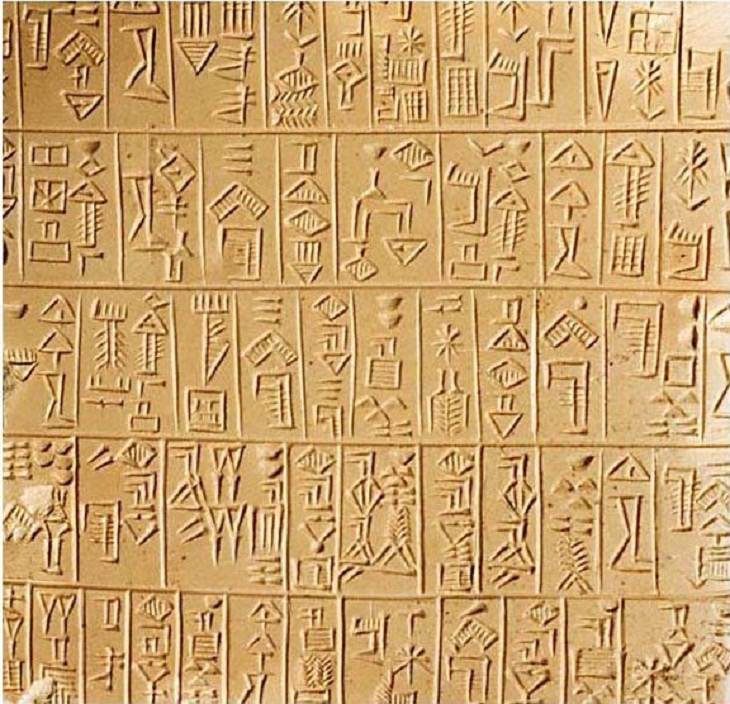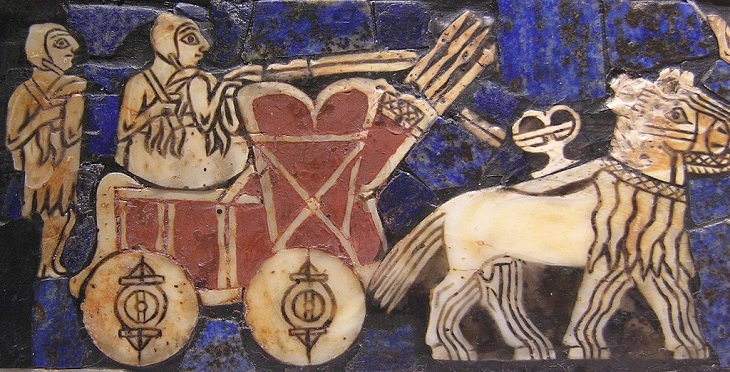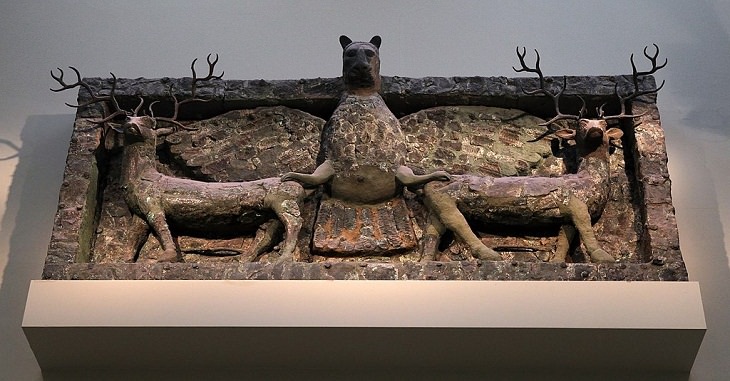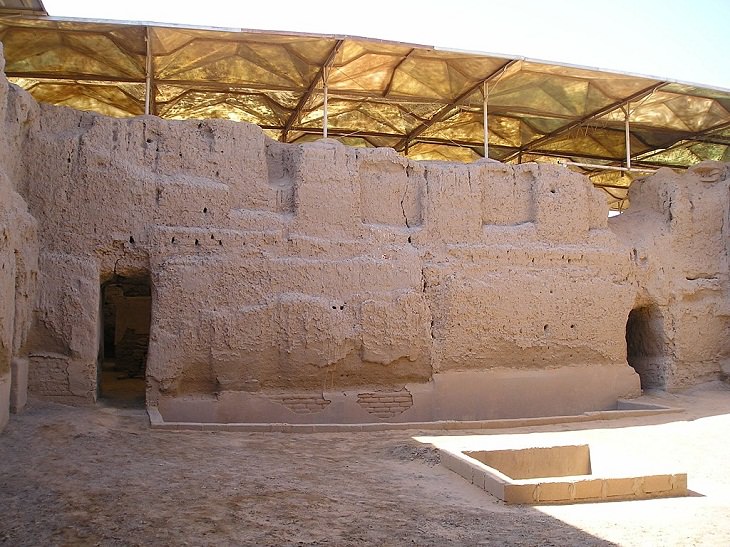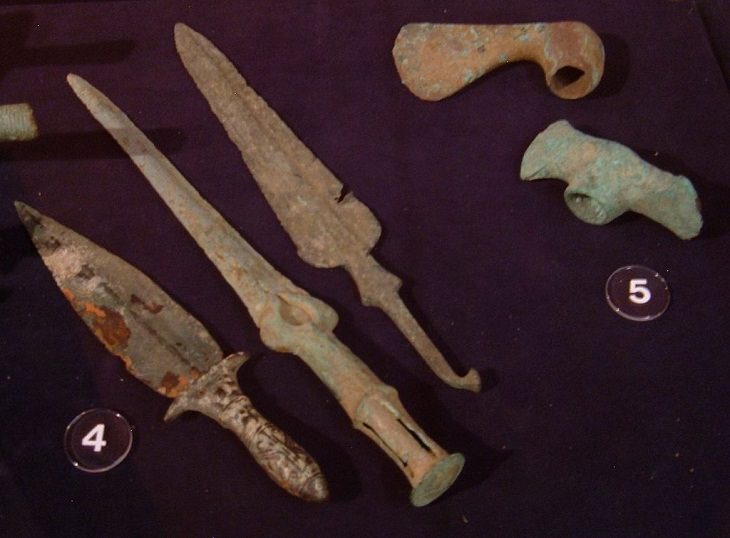Many historians believe that the Sumerians were the first to develop a writing system. Between 3500 and 3000 BC, the Sumerians developed the cuneiform script, the oldest known writing form in the world. It was a curious wedge-shaped style of writing that wasn’t meant for creating great literature or record their history. They developed it to keep a record of their goods. In fact, their very first texts were just numbers and commodities. Gradually, a stylus-like object was used to give clearer strokes and make different figures and pictorials by making cuts into soft clay. These pictographs developed into symbols that represented words and sounds.
Later on, the descendants of the Sumerians like the Babylonians, Assyrians, and Akkadians, used the cuneiform style of writing to keep records. This script was used for more than three millennia before the alphabetical form in the Roman era replaced it.
2. Chariot
While the Sumerians certainly didn’t invent wheeled vehicles, it is believed that they probably developed the first two-wheeled chariot. There’s evidence that the Sumerians used such carts for transportation circa 3000 BC. These vehicles were generally pulled by donkeys with a charioteer steering the reins. Also, they had either two or four solid wheels. While they were meant for transport, these chariots were also used for ceremonies or by the military for warfare. This especially came in handy when they had to get around the countryside where the terrain could be quite rough.
3. Use of copper
The Sumerians were known to be the first ones to use copper – the earliest non-precious metal – to make handy items. According to the Copper Development Association, they made stuff like spearheads, chisels, harpoons, and razors and other small objects using copper. Archeological evidence states that the Sumerians first began fabricating copper around 5000 BC. It was one of the greatest inventions in Mesopotamia and also led to the growth of many cities like Uruk, Sumer, al’Ubaid, and Ur.
Once they got the hang of it, the Sumerians began using copper to make bigger items like copper jugs, vessels, and chisels. Later on, they even made spectacular panels depicting mythical animals such as an eagle with a lion’s head with two stags on either side (also known as the Imdugud Relief). They beat copper to form the images of these creatures and then set it up in wood. These objects showcase the outstanding craftsmanship of the Sumerians.
4. Bricks of clay
There would often be a shortage of stones and timber in ancient Sumerian times. To make up for it, they created molds for making bricks out of clay for building their houses. The Sumerians weren’t, of course, the first to use clay as a building material. However, clay was Sumer’s most abundant material. And historians believe that they did innovate the ability to produce bricks of clay in large amounts and set them on a massive scale. They probably mixed the clay with sand, water, mud, organic material, and husks or straw to create the bricks.
While these buildings weren’t as sturdy as the ones made of stone, they did the work quite well and the Sumerians went on to build many such buildings with bricks of clay and even created large cities using them. You can still find mud-brick structures throughout former Mesopotamia.
5. Weapons
Ancient records state that the Sumerian people were the first to use weapons made out of copper. They invented spears, swords, maces, slings, and clubs from copper and used it widely in warfare. The Sumerians even used clay to make sickles alongside axes and spears. In fact, the socketed ax was one of the most prominent weapons to be invented by the Sumerians that gradually evolved into the piercing axes. These inventions were necessary as the city-states of Sumer were constantly embroiled in war.
6. The oldest complete board game
The Royal Game of Ur, also known as the Game of Twenty Squares was invented sometime between 2600 and 2400 BC and is the oldest complete board game ever discovered. The remains of the game were found in the Royal Tombs of Ur, Iraq, during the 1920s, by Sir Leonard Woolley. Exactly how the game was played is still unknown but it is believed to be a two-player strategy race board game that went on to become immensely popular.
Four tetrahedral dice with seven markers were used in the game and it was possibly a precursor to backgammon, one of the oldest known board games. Indeed, the Royal Game of Ur paved the path for several other board games to be invented in the centuries to follow.
7. Lunar Calendar
Historians have noted that the Sumerians were probably the first to develop the lunar calendar. They used the phases of the moon to count the 12 months of the year. The Sumerians had two seasons in their year - summer and winter. Summer began with the vernal equinox while winter commenced with the autumn equinox. Furthermore, sacred marriage rites were performed on the first day of the New Year. Interestingly, they added an extra month every four years to their lunar calendar which allowed them to define a ‘year of seasons’. This lunar calendar is still used among a few religious groups today.
8. Advanced Astronomy
The Sumerians were also the first to record the names of the constellations and are believed to have first done so by about 2000 BC. The zodiacal constellations, the ones that the Sun, Moon, and planets all pass through, were the most significant to the Sumerians. Moreover, they even used astrological symbols to predict future battles and the fate of city-states. Their month began with the sunset and the first crescent of the new moon while the day consisted of 12 hours which started and ended with the sunset.
Later on, the Babylonians kept the Sumerian calendar system and the names of their constellations. The ancient Greeks, too, observed this calendar later. In fact, several zodiacal constellations that we use now originate from Sumer.
Share this post with someone who likes history...

